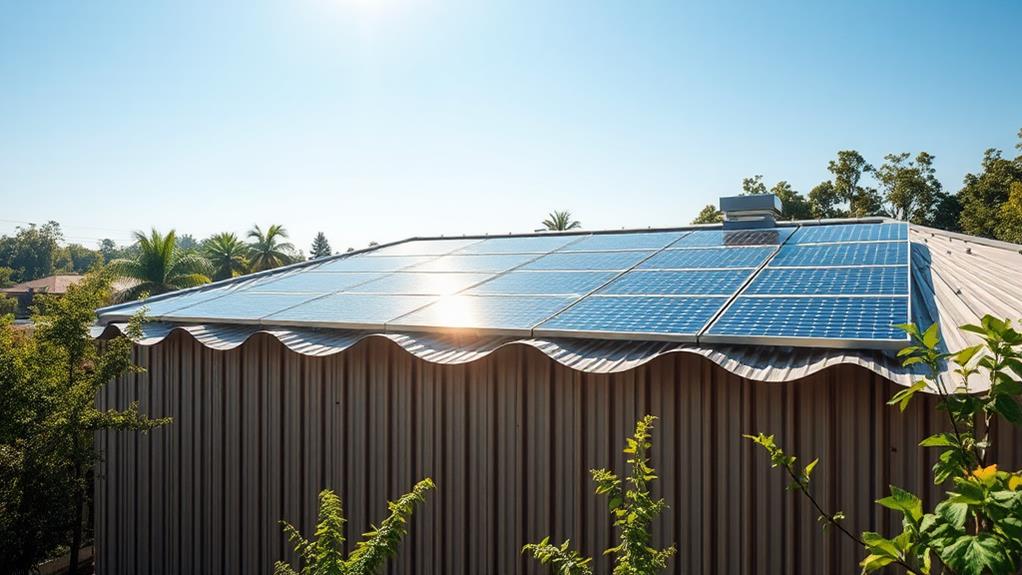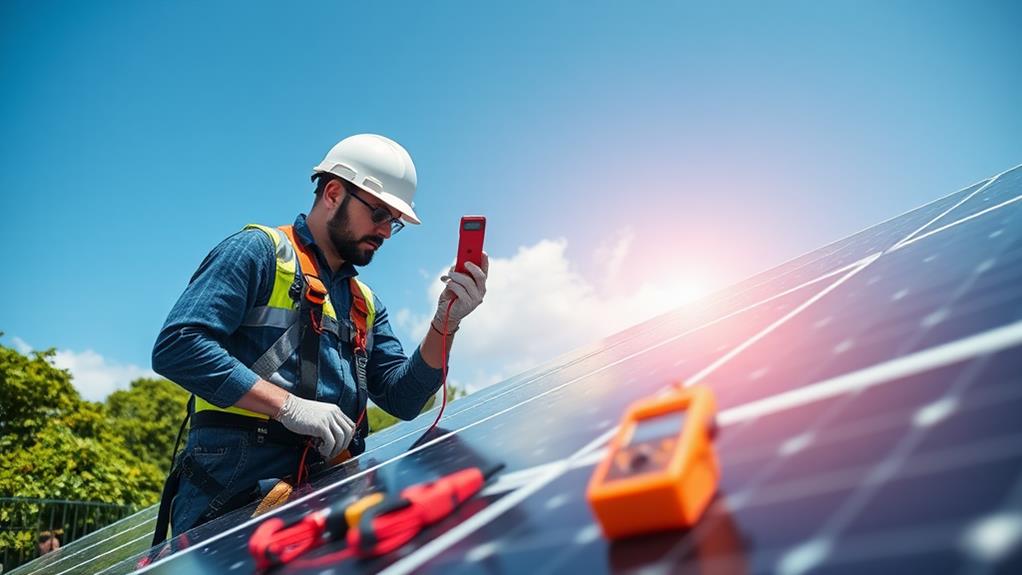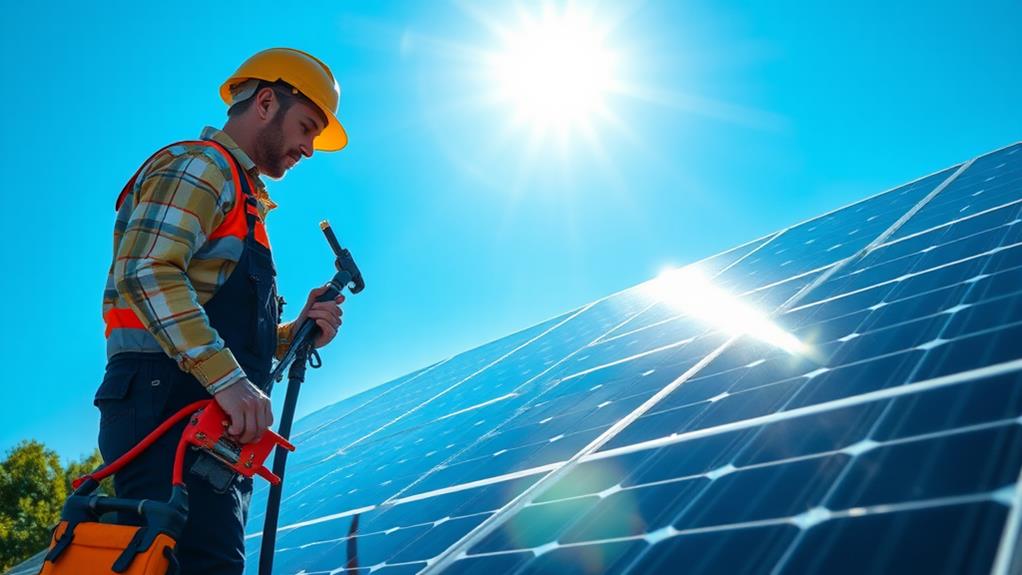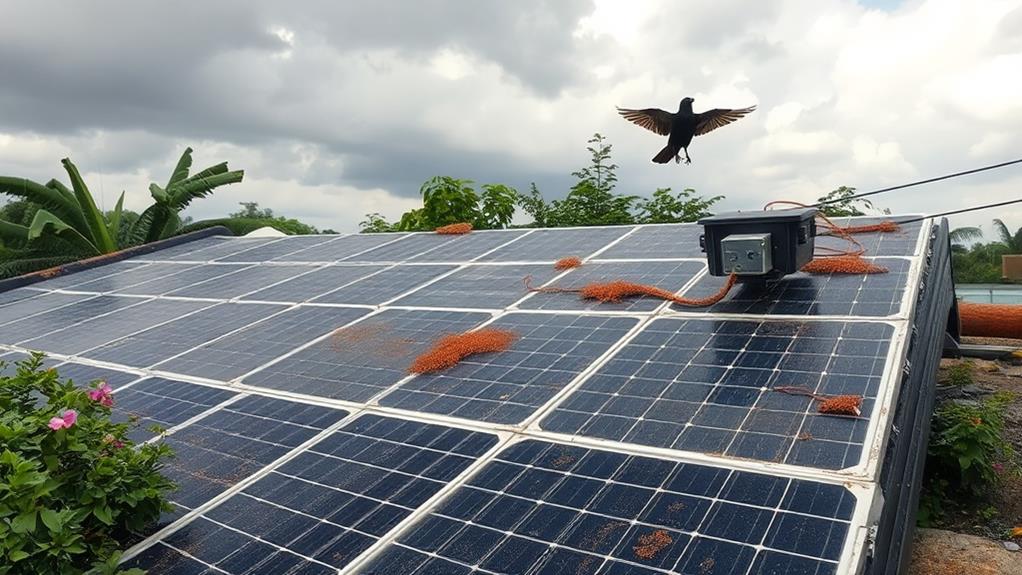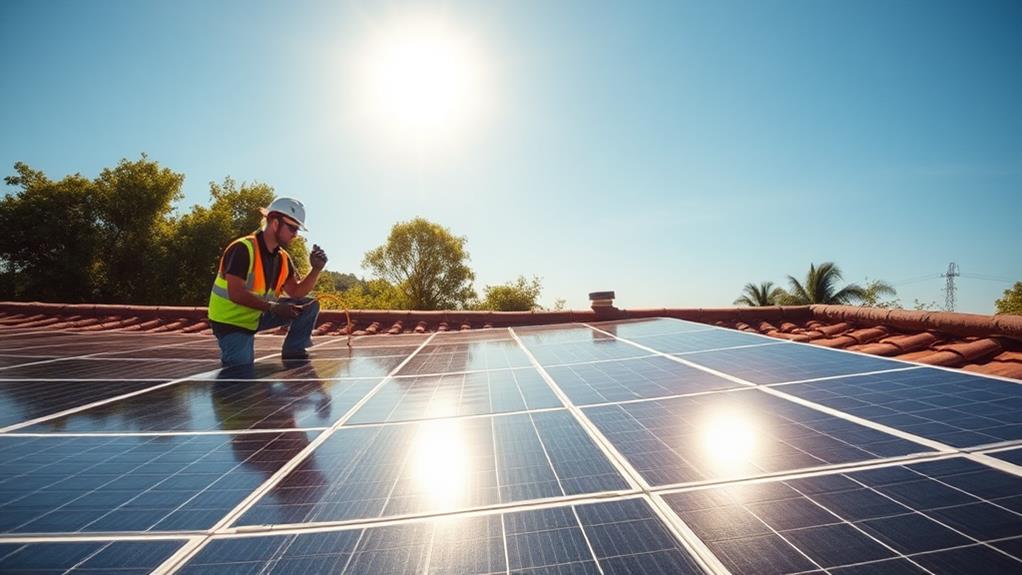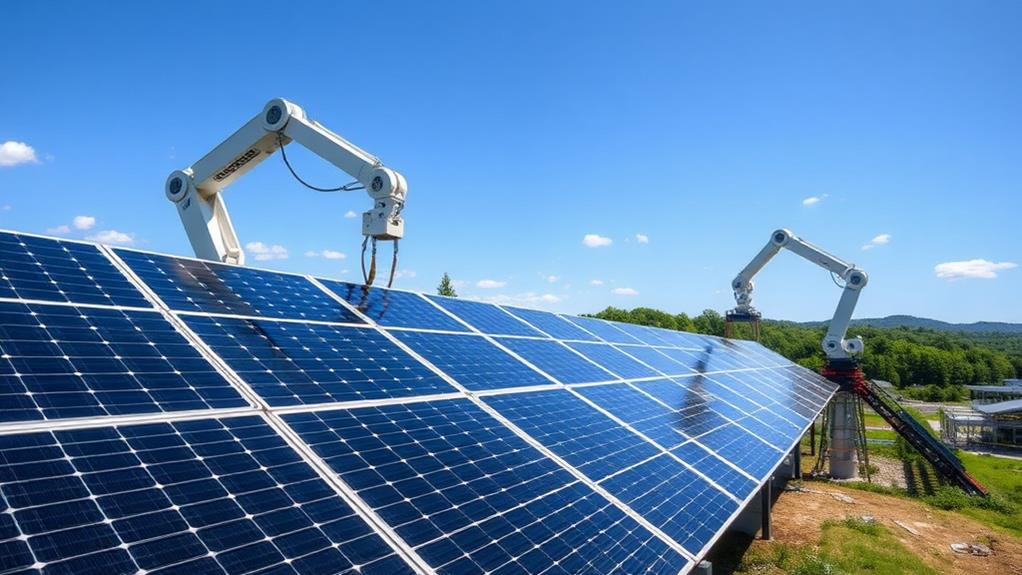When we set up solar panels on wavy roofs, we initially evaluate the roof's suitability by examining its structural strength and ensuring it can support the weight. We choose durable, rust-resistant materials, such as stainless steel fasteners and compatible sealants, to prevent leaks and extend roof life. Optimizing panel placement is critical; it involves analyzing sunlight exposure and avoiding shading. Safety is our top priority, so we adhere to electrical protocols and local codes. Regular maintenance, including debris cleaning and damage inspection, keeps the system efficient. By focusing on these practices, we grasp how each step improves the overall result and dependability.
Key Takeaways
- Conduct a thorough roof inspection to ensure structural capability and check for leaks or damage.
- Select corrosion-resistant fasteners and sealants that are compatible with solar panels for longevity.
- Use gasket seals to protect against leaks and maintain roof integrity.
- Optimize panel placement for maximum sunlight exposure by considering roof pitch and orientation.
- Follow safety protocols, including fall protection and electrical safety, during installation.
Assess Roof Suitability
When considering the installation of solar panels on corrugated roofs, it's essential to assess the roof's suitability. Begin with a thorough roof inspection to confirm that the structure can handle the additional weight. Our shared goal is to ensure our community thrives with renewable energy, so it's important to ensure our roofs are capable. Check for any existing leaks or damage that could lead to water ingress during installation. Addressing these issues early prevents future problems and provides peace of mind with a solid foundation.
Evaluate the roof's age and condition. Older roofs mightn't support the weight of solar panels, so understanding their strength is critical. Verify the weight capacity to ensure the roof can accommodate the solar panels and any necessary mounting hardware. This step is crucial for both safety and efficiency.
Consider the pitch and orientation to optimise sunlight exposure, maximising solar energy production. Collaborating to assess these factors guarantees our corrugated roofs are prepared to support a sustainable future, one solar panel at a time.
For example, the SolarEdge HD-Wave Inverter is an excellent choice for optimising energy production. It's designed to maximise the efficiency of solar panels, ensuring the best performance. Additionally, the Renusol MetaSole+ mounting system can be a reliable option for securing solar panels on corrugated roofs. These products can help enhance the overall setup and ensure the solar panels are installed securely and efficiently.
Select Appropriate Hardware
When selecting hardware for installing solar panels on corrugated roofs, we must prioritize sealant compatibility to prevent leaks.
It's crucial to choose corrosion-resistant fasteners to guarantee durability and weatherproofing.
Let's make sure that all components work seamlessly with the solar panels and the unique demands of corrugated roofing.
Sealant Compatibility Check
To ensure the longevity and effectiveness of solar installations on corrugated roofs, selecting compatible sealants is vital. The right products guarantee excellent performance, crucial for preventing water leakage and maintaining roof integrity. Weatherproofing techniques must protect against varying weather conditions. Sealants specifically designed for corrugated metal roofs create a durable barrier against moisture intrusion.
Corrosion-resistant sealants are ideal for exposed fastener installations. These specialised sealants withstand temperature fluctuations and expansion typical of corrugated metal roofs. Proper application is key to achieving optimal weatherproofing results. As members of a community dedicated to sustainable energy solutions, we must uphold the highest standards in every detail, including sealant selection.
Before making a choice, verifying the sealant's performance and durability is necessary. Thorough checks ensure long-lasting protection against leaks, keeping solar installations efficient.
We should consider products like Soudal Fix All Crystal, known for its strong adhesion properties and flexibility. Working together to select the right sealants fosters trust and belonging in our shared mission for a sustainable future.
Corrosion-Resistant Fasteners Selection
Selecting the correct fasteners for corrugated roof solar installations ensures durability and resistance to corrosion. Our community highly values long-lasting solutions. Stainless steel fasteners are the preferred choice for combating corrosion and maintaining durability over time. They work seamlessly with corrugated metal roofs, providing the necessary compatibility to prevent any complications.
To avoid galvanic corrosion, match fasteners with aluminium or stainless steel washers. This combination ensures solar installations remain securely in place, even when exposed to harsh weather conditions. Powder-coated or galvanised fasteners provide an extra layer of protection against rust and corrosion.
For instance, products like the Fischer Power-Fast II screws offer excellent corrosion resistance due to their zinc flake coating.
Self-drilling screws with EPDM rubber washers establish a weather-resistant seal, further protecting installations. Verifying fastener compatibility with the metal type of the roof prevents undesired chemical reactions and deterioration. This ensures a sense of security and unity. Making knowledgeable decisions safeguards investments and reinforces our collective dedication to sustainable energy solutions.
Ensure Proper Sealing
As we install solar panels on corrugated roofs, we must focus on effective sealant application to prevent water leakage.
By selecting durable, corrosion-resistant materials, we help maintain the roof's integrity and protect our investment.
Let's make sure that every sealing detail is carefully attended to, safeguarding our installation from potential water damage.
Effective Sealant Application
Applying sealant effectively on corrugated roofs is essential for preventing leaks and ensuring the roof's longevity, particularly when incorporating solar panels. The shared objective is to create a robust roofing system that withstands time and weather. To achieve sealant longevity, selecting quality products specifically designed for metal roofs is critical. These sealants, combined with proper weatherproofing methods, provide optimal protection against the elements.
Integrating solar panels involves drilling into the roof, which can compromise its structure. Sealants play a crucial role in maintaining a waterproof barrier. Rubber gasket seals are also invaluable, offering additional security by effectively sealing penetrations to ensure durable and reliable installations.
For metal roofs, consider using Sika Sikaflex®-11 FC, a high-performance, multipurpose sealant and adhesive known for its excellent adhesion and elasticity.
Alternatively, Geocel Trade Mate Roofers Seal provides excellent weather resistance and adhesion to various surfaces, including metal.
Incorporating products like these ensures that the roofing system remains watertight and secure, even after the installation of solar panels.
Preventing Water Leakage
Ensuring proper sealing is crucial in preventing water leakage in solar panel installations on corrugated metal roofs. We aim to be confident that our efforts in adopting sustainable energy won't lead to water damage. Understanding waterproofing techniques and leak prevention strategies is essential. Correctly applying the right sealant protects both our solar investment and the integrity of our roofs.
Corrugated metal roofs require penetrative fasteners for mounting solar panels, making them prone to leaks if not properly sealed. High-quality, corrosion-resistant sealants are vital. These sealants ensure the fasteners remain watertight, offering long-term protection against water infiltration. It's important to select a sealant that withstands the elements and time. For example, SikaFlex-11 FC+ is renowned for its durability and resistance to harsh weather conditions.
Precision in applying sealants on fasteners and penetrations is key. This meticulous application prevents potential leaks. Each sealant choice and application contributes to a leak-free solar installation.
Prioritising sealing practices safeguards our corrugated roofs, allowing us to enjoy the benefits of solar energy without worrying about water damage.
Selecting Durable Materials
Choosing suitable materials is critical for ensuring durable and waterproof solar installations on corrugated roofs. Rubber gasket seals are ideal for this purpose. They provide a superior sealing solution compared to traditional sealants. Using these gaskets during installation protects the roof from potential leaks and maintains its structural integrity while supporting the solar panels.
Gasket seals are essential for the long-term reliability and cost-effectiveness of solar installations. They offer strong defence against weather elements, extending the lifespan of both the roof and the solar system. Prioritising proper sealing with gaskets minimises the risk of long-term damage, ensuring that the investment remains secure and that the energy-producing community thrives.
Ensuring solar installations endure the test of time is important, providing sustainable energy without unexpected maintenance costs. Selecting durable materials and focusing on effective sealing techniques achieves a balance between performance and peace of mind. Adopting best practices helps build a future where reliable, renewable energy is enjoyed.
For product recommendations, consider EPDM rubber gasket seals, known for their excellent weather resistance and durability. Additionally, neoprene gasket seals are a good choice due to their resilience and versatility in various environmental conditions. These options can enhance the efficiency and longevity of solar installations.
Optimize Panel Placement
In optimising panel placement on corrugated roofs, maximising sun exposure is crucial for enhancing energy generation. Sunlight angles and roof shading must be assessed to achieve peak efficiency. Panels should be strategically positioned to ensure they're oriented to capture the most sunlight throughout the day. This requires considering the sun's path and adjusting the tilt angles according to the roof's slope. This approach can significantly reduce the impact of shading from nearby obstructions, ensuring panels operate at peak performance.
Proper orientation harnesses the full potential of solar energy. Careful planning of panel placement, taking into account the direction and intensity of sunlight, leads to greater energy savings and a higher return on investment. This method helps foster a sense of community, as we collectively benefit from improved energy efficiency. Together, we can positively impact the environment and enjoy reduced energy costs. Prioritising optimal panel placement means investing in our homes and a sustainable future for all. Let's advance towards cleaner energy, one panel at a time.
For instance, the JA Solar Mono PERC 455W panel offers excellent performance with high efficiency, making it a suitable choice for residential installations. Additionally, the Renusol Console+ mounting system provides secure and adaptable solutions for various roofing types. These products help ensure that solar panels are installed correctly and efficiently, maximising energy generation potential.
Follow Safety Protocols
Maximising solar panel efficiency is essential, but maintaining safety during installation is equally important. Safety training should be prioritised to protect oneself and colleagues. Fall protection equipment is vital when working on corrugated roofs. Adhering to these protocols creates a safer environment for everyone.
Electrical hazards present significant risks during solar installations. Strict electrical safety protocols should always be followed to minimise these risks. A shared commitment to safety training helps maintain alertness and knowledge about potential dangers. Learning from each other and following established guidelines reduces the likelihood of accidents, safeguarding the wellbeing of the entire team.
Properly sealing roof penetrations with corrosion-resistant sealants is crucial. This practice prevents water leakage and maintains the integrity of corrugated metal roofs. Regularly reviewing and adhering to local building codes and regulations ensures compliance and safety. Using UL-listed sealants and attachments, such as SikaFlex, ensures long-term protection and durability for installations. These practices form the foundation of a safe and successful solar project. Safety should be a shared mission.
Perform Thorough Inspections
Before commencing solar panel installation, conducting thorough inspections of the corrugated roof is essential. Ensuring the roof's integrity and weather resistance meets standards is crucial for a successful project.
Assessing the structural soundness of the roof is the first step. It's important to ensure it can support the weight of the solar panels without compromising safety or stability. Identifying any existing damage, such as rust or corrosion, is vital as these issues could impede a successful installation.
Inspecting for proper drainage and water flow is also necessary. Preventing water from pooling or leaking is important, as it could affect the solar panel system and disrupt the overall installation process. Each team member plays a part in this collective effort, ensuring the roof is prepared to withstand various weather conditions.
For example, using a product like the Bosch Professional GWS 18V-10 Cordless Angle Grinder can aid in removing corrosion effectively. Additionally, checking for signs of water accumulation or faulty drainage systems ensures the roof remains watertight. Addressing these issues promptly guarantees a smooth installation and long-term durability of both the roof and solar panels.
Plan for Maintenance
Regular upkeep ensures our corrugated roof solar installations operate efficiently and endure for years. Committing to a regular maintenance schedule not only protects the system's integrity but also fosters a sense of community and shared responsibility.
Tasks like cleaning debris and inspecting for damage can be tackled together, contributing to the long-term health of our solar setups.
Planning for maintenance requires consideration of costs. Regular checks may appear as an added expense, but they prevent potential energy losses and costly repairs in the future. Investing in scheduled maintenance enhances system performance and customer satisfaction, creating a network of reliable, high-performing solar installations.
Our solar network thrives on active participation and vigilance.
Consistent maintenance optimises energy output and reliability. Acknowledge our role in this collective effort to ensure each corrugated roof solar installation reaches its full potential. Following these best practices contributes to a sustainable and efficient energy future.
Conclusion
We've covered the important steps for installing solar panels on corrugated roofs. First, check if your roof is suitable and pick the right hardware. This forms a solid foundation. Proper sealing and smart panel placement ensure they work well and last a long time. Remember to follow safety rules and do thorough checks to keep everything running smoothly. Planning for maintenance helps tackle any future issues.
If you have any questions or need more information about our products like Rail-Less Solar Brackets, End Spacers, Structural Brackets, Ground Mounted Solar Systems, Corrugated Brackets, and Earthing Plates, or our services such as DeoSizer Tool, Evaluation and Design, Maintenance and Support, or Solar Installations, don't hesitate to reach out to us at Deo Solar. We're here to help you make the most of solar energy efficiently and responsibly.

